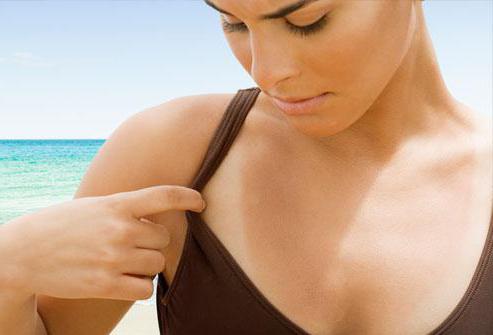The features of the impact of direct sunlight on the body today are of interest to many, especially those who want to spend the summer with benefit for themselves, stock up on solar energy and get a beautiful healthy tan. What is solar radiation and what effect does it have on us?
Definition
The sun's rays (photo below) are a stream of radiation, which is represented by electromagnetic oscillations of waves of different lengths. The spectrum of radiation emitted by the sun is diverse and wide both in terms of wavelength and frequency, and in terms of its effect on the human body.
Types of sunbeams
There are several regions of the spectrum:
- Gamma radiation.
- X-ray radiation (wavelength - less than 170 nanometers).
- Ultraviolet radiation (wavelength - 170-350 nm).
- Sunlight (wavelength - 350-750 nm).
- Infrared spectrum, which has a thermal effect (wavelengths - more than 750 nm).
In terms of biological influence on a living organism, ultraviolet rays of the sun are the most active. They contribute to the formation of tanning, have a hormone-protective effect, stimulate the production of serotonin and other important components that increase vitality and vitality.

Ultraviolet radiation
In the ultraviolet spectrum, 3 classes of rays are distinguished, which affect the body in different ways:
- A-rays (wavelength - 400-320 nanometers). They have the lowest level of radiation; they remain constant in the solar spectrum throughout the day and year. There are almost no barriers for them. The harmful effect of sunlight of this class on the body is the lowest, however, their constant presence accelerates the process of natural aging of the skin, because, penetrating to the growth layer, they damage the structure and base of the epidermis, destroying elastin and collagen fibers.
- B-rays (wavelength - 320-280 nm). Only at certain times of the year and hours of the day do they reach the Earth. Depending on the geographic latitude and air temperature, they usually enter the atmosphere from 10:00 to 16:00. These rays of the sun take part in the activation of the synthesis of vitamin D3 in the body, which is their main positive property. However, with prolonged exposure to the skin, they are able to change the genome of cells in such a way that they uncontrollably begin to multiply and form cancer.
- C-rays (wavelength - 280-170 nm). This is the most dangerous part of the UV spectrum, unconditionally provoking the development of cancer. But in nature, everything is very wisely arranged, and the harmful C rays of the sun, like most (90 percent) of the B rays, are absorbed by the ozone layer before reaching the Earth's surface. So nature protects all living things from extinction.

Positive and negative impact
Depending on the duration, intensity, frequency of exposure to UV radiation, positive and negative effects develop in the human body. The former include the formation of vitamin D, the production of melanin and the formation of a beautiful, even tan, the synthesis of mediators regulating biorhythms, the production of an important regulator of the endocrine system - serotonin. That is why after the summer we feel a surge of strength, an increase in vitality, a good mood.
The negative effects of ultraviolet exposure are skin burns, damage to collagen fibers, the appearance of cosmetic defects in the form of hyperpigmentation, provoking cancer.

Synthesis of vitamin D
When exposed to the epidermis, the energy of solar radiation is converted into heat or spent on photochemical reactions, as a result of which various biochemical processes are carried out in the body.
Vitamin D is supplied in two ways:
- endogenous - due to the formation in the skin under the influence of UV rays B;
- exogenous - due to intake with food.
The endogenous pathway is a rather complex process of reactions that occur without the participation of enzymes, but with the mandatory participation of UV irradiation with B rays. With sufficient and regular insolation, the amount of vitamin D3 synthesized in the skin during photochemical reactions fully meets all the needs of the body.
Sunburn and vitamin D
The activity of photochemical processes in the skin directly depends on the spectrum and intensity of exposure to ultraviolet radiation and is inversely related to sunburn (degree of pigmentation). It has been proven that the more pronounced the tan, the more time it takes for the accumulation of provitamin D3 in the skin (instead of fifteen minutes, three hours).

From the point of view of physiology, this is understandable, since tanning is a protective mechanism of our skin, and the melanin layer formed in it acts as a certain barrier to both UV B rays, which serve as a mediator of photochemical processes, and class A rays, which provide the thermal stage of transformation in the skin provitamin D3 to vitamin D3.
But vitamin D supplied with food only compensates for the deficiency in case of insufficient production in the process of photochemical synthesis.
Formation of vitamin D when exposed to the sun
Today it has already been established by science that to meet the daily need for endogenous vitamin D3, it is enough to stay under open solar UV rays of class B for ten to twenty minutes. Another thing is that such rays are not always present in the solar spectrum. Their presence depends both on the season of the year and on the geographic latitude, since the Earth, during rotation, changes the thickness and angle of the atmospheric layer through which the sun's rays pass.
Therefore, the radiation of the sun is not constantly able to form vitamin D3 in the skin, but only when UV B rays are present in the spectrum.

Solar radiation in Russia
In our country, taking into account the geographical location, periods of solar radiation rich in UV rays of class B are unevenly distributed. For example, in Sochi, Makhachkala, Vladikavkaz they last about seven months (from March to October), and in Arkhangelsk, St. Petersburg, Syktyvkar last about three (from May to July) or even less. Add to this the number of cloudy days a year, the smoky atmosphere in large cities, and it becomes clear that most of the inhabitants of Russia experience a lack of hormonotropic solar exposure.
This is probably why we intuitively strive for the sun and rush to the southern beaches, while forgetting that the sun's rays in the south are completely different, unusual for our body, and, in addition to burns, can provoke strong hormonal and immune surges that can increase the risk of cancer and other ailments .
At the same time, the southern sun is able to heal, just a reasonable approach must be observed in everything.




